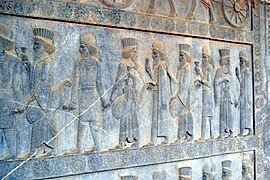
History of Iran
The history of Iran (or Persia, as it was commonly known in the Western world) is intertwined with that of Greater Iran, a sociocultural region spanning the area between Anatolia in the west and the Indus River and Syr Darya in the east, and between the Caucasus and Eurasian Steppe in the north and the Persian Gulf and the Gulf of Oman in the south. Central to this area is the modern-day country of Iran, which covers the bulk of the Iranian plateau.
Iran is home to one of the world's oldest continuous major civilizations, with historical and urban settlements dating back to 4000 BC.[1] The south-western and western part of the Iranian plateau participated in the traditional ancient Near East with Elam (3200–539 BC), from the Bronze Age, and later with various other peoples, such as the Kassites, Mannaeans, and Gutians. Georg Wilhelm Friedrich Hegel calls the Persians the "first Historical People".[2] The Medes unified Iran as a nation and empire in 625 BC.[3] The Achaemenid Empire (550–330 BC), founded by Cyrus the Great, ruled from the Balkans to North Africa and also Central Asia, spanning three continents, from their seat of power in Persis (Persepolis). It was the largest empire yet seen.[4] They were succeeded by the Seleucid, Parthian, and Sasanian Empires, who successively governed Iran for almost 1,000 years and made Iran once again a leading power in the world. Persia's arch-rival was the Roman Empire and its successor, the Byzantine Empire.
The Iranian Empire proper begins in the Iron Age, following the influx of Iranian peoples. Iranian people gave rise to the Medes, the Achaemenid, Parthian, and Sasanian Empires of classical antiquity.
Once a major empire, Iran has endured invasions too, by the Macedonians, Arabs, Turks, and Mongols. Iran has continually reasserted its national identity throughout the centuries and has developed as a distinct political and cultural entity.
The Muslim conquest of Persia (632–654) ended the Sasanian Empire, and was a turning point in Iranian history. Islamization of Iran took place during the eighth to tenth centuries, leading to the eventual decline of Zoroastrianism in Iran as well as many of its dependencies. However, the achievements of the previous Persian civilizations were not lost but were to a great extent absorbed by the new Islamic polity and civilization.
Iran, with its long history of early cultures and empires, had suffered particularly hard during the Late Middle Ages and the early modern period. Many invasions of nomadic tribes, whose leaders became rulers in this country, affected it negatively.[5]
Iran was reunified as an independent state in 1501 by the Safavid dynasty, which set Shia Islam as the empire's official religion,[6] marking one of the most important turning points in the history of Islam.[7] Functioning again as a leading world power, this time amongst the neighbouring Ottoman Empire, its arch-rival for centuries, Iran had been a monarchy ruled by an emperor almost without interruption from 1501 until the 1979 Iranian Revolution, when Iran officially became an Islamic republic on 1 April 1979.[8][9]
Over the course of the first half of the 19th century, Iran lost many of its territories in the Caucasus, which had been a part of Iran for centuries,[10] comprising modern-day Eastern Georgia, Dagestan, Republic of Azerbaijan, and Armenia, to its rapidly expanding and emerging rival neighbor, the Russian Empire, following the Russo-Persian Wars between 1804–1813 and 1826–1828.[11]








